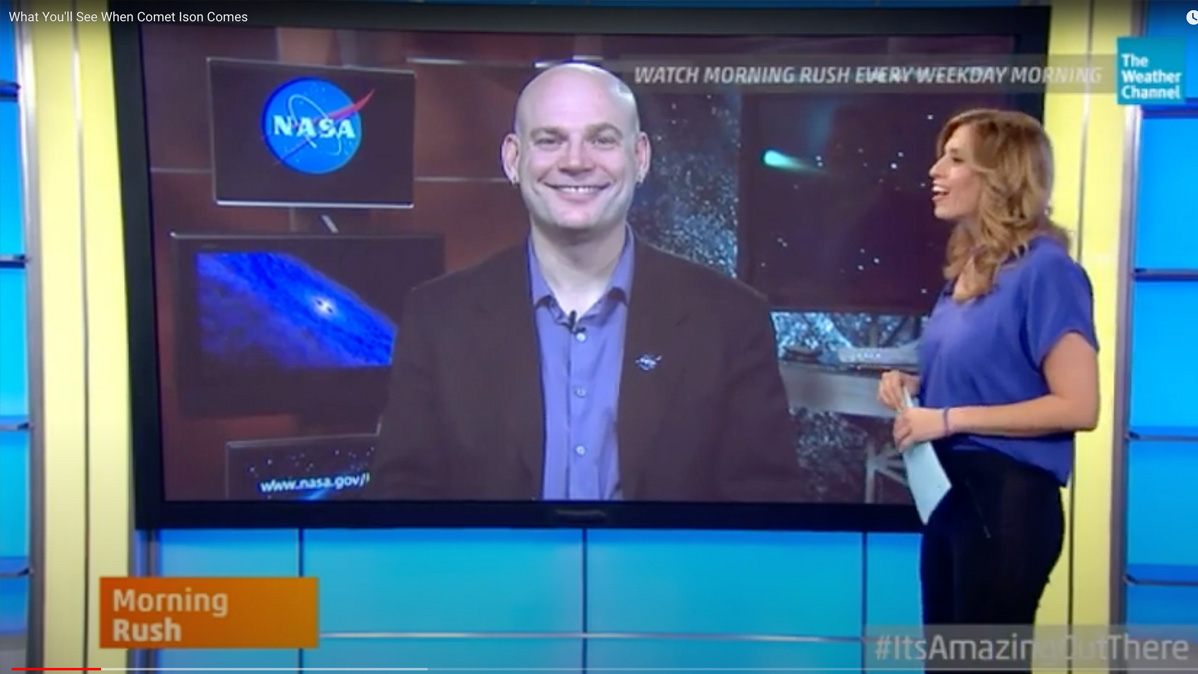Live TV Interviews for NASA
2024 Total Solar Eclipse
The Weather Channel
April 8, 2024 Total Solar Eclipse
October 14, 2023 Annular Eclipse Live Coverage
The Sun Today’s C. Alex Young was live in San Antonio with The Weather Channel’s Alex Wilson! Check out all of TWC’s coverage. Look for Alex Young on other segments talking about space weather, the April 8, 2024 eclipse, and other Sun topics.
Understanding Space Weather
Oct 9, 2019 – Did you know there’s weather in space? We spoke with NASA scientist Dr. Alex Young ahead of October 9th’s launch of #NASAICON. CREDIT: The Weather Channel
Sungrazer Comet ISON
Can Comet Ison Survive the Sun?
Nov 26, 2013 – Al Roker and Stephanie Abrams talks to NASA scientist Alex Young about Comet Ison and what will happen if it survives the suns atmosphere. CREDIT: The Weather Channel
What You’ll See When Comet Ison Comes
Nov 26, 2013 – Stephanie Abrams talks to NASA scientist Alex Young about what you can see when Comet Ison is visible. CREDIT: The Weather Channel; View on YouTube
TV Show
National Geographic Special: Mission to the Sun
NASA is sending a tiny spacecraft closer to the sun than any man-made object has ever been and faster than any man-made object has ever traveled.
Photo credits: National Geographic
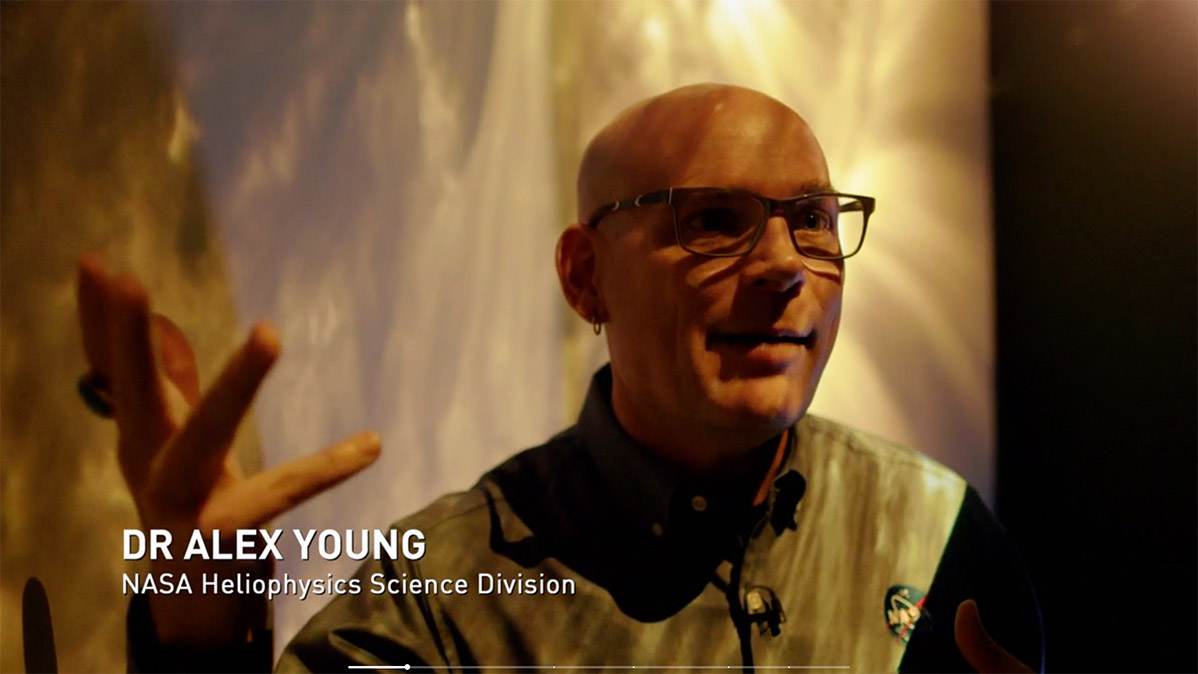
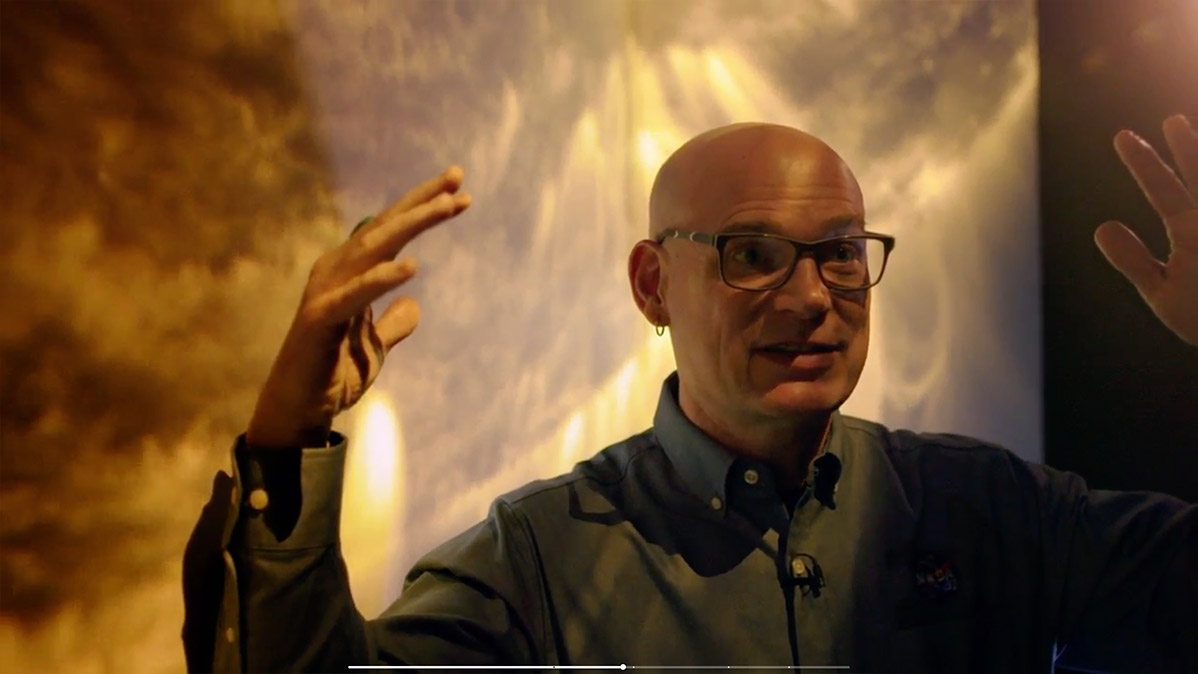
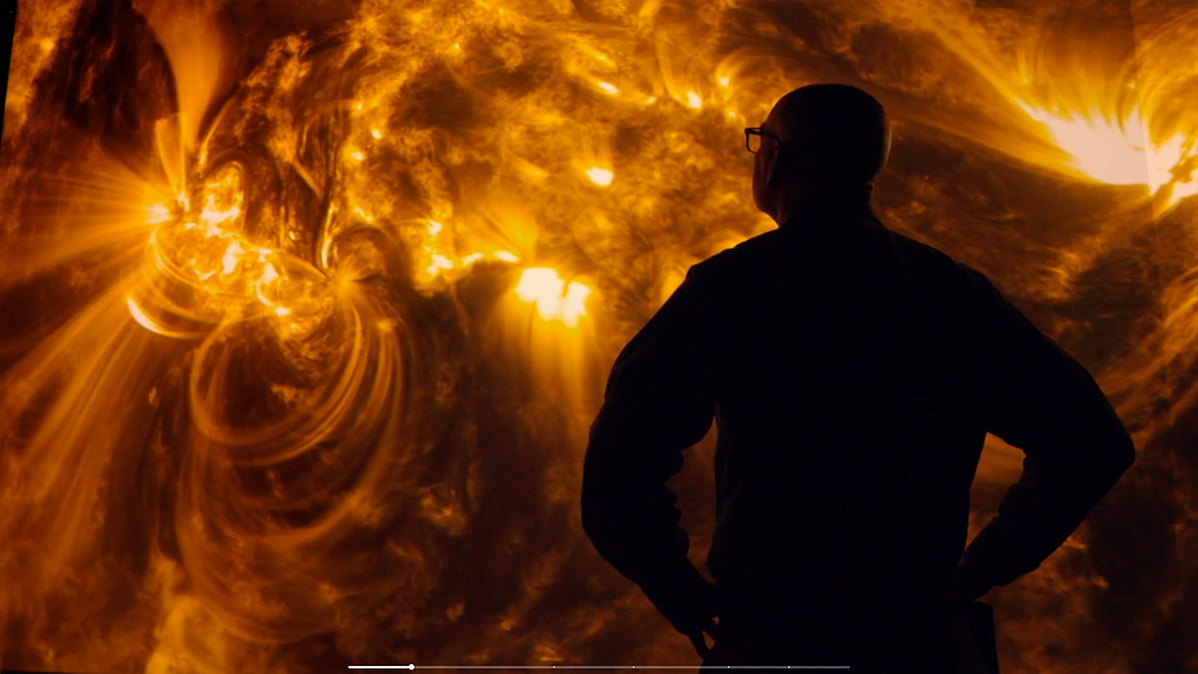
NASA Live Broadcasts
NASA TV Coverage for Solar Orbiter Launch
Launched February 9, 2020 – This mission is designed to perform unprecedented close-up observations of the Sun and from high-latitudes, providing the first images of the uncharted polar regions of the Sun, and investigating the Sun-Earth connection. Alex Young was interviewed by Franklin Fitzgerald of NASA Edge about the mission and how it compliments Parker Solar Probe.
NASA TV Coverage for Parker Solar Probe
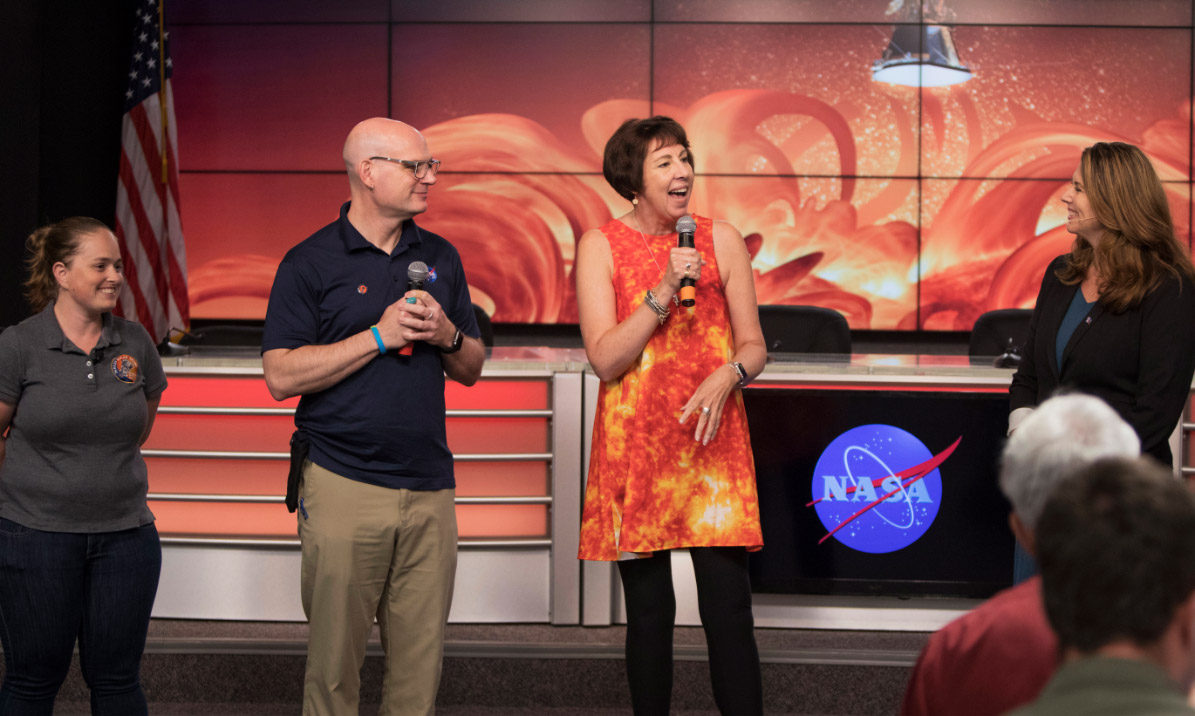
Pre-launch Science Briefing for Parker Solar Probe Early on an August morning, the sky near Cape Canaveral, Florida, will light up with the launch of Parker Solar Probe. No earlier than Aug. 6, 2018, a United Launch Alliance Delta IV Heavy will thunder to space carrying the car-sized spacecraft, which will study the Sun closer than any human-made object ever has.
On July 20, 2018, Nicky Fox, Parker Solar Probe’s project scientist at the Johns Hopkins University Applied Physics Lab in Laurel, Maryland, and Alex Young, associate director for science in the Heliophysics Science Division at NASA’s Goddard Space Flight Center in Greenbelt, Maryland, introduced Parker Solar Probe’s science goals and the technology behind them at a televised press conference from NASA’s Kennedy Space Center in Cape Canaveral, Florida.
“We’ve been studying the Sun for decades, and now we’re finally going to go where the action is,” said Young.
CREDIT: NASA, Music by Kevin Macleod
In the Kennedy Space Center’s Press Site auditorium, on Friday, July 20, 2018, agency and mission leaders speak to members of the media during a prelaunch briefing for the Parker Solar Probe mission. From left are: Betsy Congdon, Thermal Protection System engineer with Johns Hopkins Applied Physics Laboratory, Alex Young, solar scientist at NASA’s Goddard Space Flight Center in Greenbelt, Maryland, Nicky Fox, project scientist with the Johns Hopkins University APL, and Karen Fox of NASA Communications. The Parker Solar Probe will lift off on a United Launch Alliance Delta IV Heavy rocket from Space Launch Complex 37 at Cape Canaveral Air Force Station in Florida. The spacecraft was built by Applied Physics Laboratory of Johns Hopkins University in Laurel in Maryland. The mission will perform the closest-ever observations of a star when it travels through the Sun’s atmosphere, called the corona. The probe will rely on measurements and imaging to revolutionize understanding of the corona and the Sun-Earth connection.
Early in the morning of Aug. 12, NASA launched Parker Solar Probe, humanity’s first mission to the Sun. This spacecraft will fly closer to the Sun than any before it, in a daring journey facing brutal heat and radiation.
Parker Solar Probe sets its sights on the Sun’s scorching outer atmosphere, called the corona, in order to solve our star’s greatest mysteries. It will revolutionize our understanding not only of the Sun, but also the space around us, and even the lives of stars beyond our solar system — crucial information as we explore more of space.
On Aug. 10, Scientists and mission experts gathered at NASA’s Kennedy Space Center for a live sunset show — one of the last times the Sun set on Parker Solar Probe before it launched — to talk about what this landmark mission will teach us of the Sun. Guests included Jim Spann, Chief Solar Scientist, NASA HQ; Yari Collado-Vega, Space Weather Scientist, NASA Goddard; C. Alex Young, Solar Scientist, NASA Goddard; Nicola Fox, Parker Solar Probe Project Scientist, JHU Applied Physics Laboratory (APL)
NASA TV Coverage for the 2017 Total Solar Eclipse
NASA TV presented four hours of coverage of the August 21, 2017, total solar eclipse as it crosses the continental United States. It was the first such eclipse in 99 years and the first total solar eclipse visible in any part of the U.S. since 1979. C. Alex Young was one of the co-hosts.
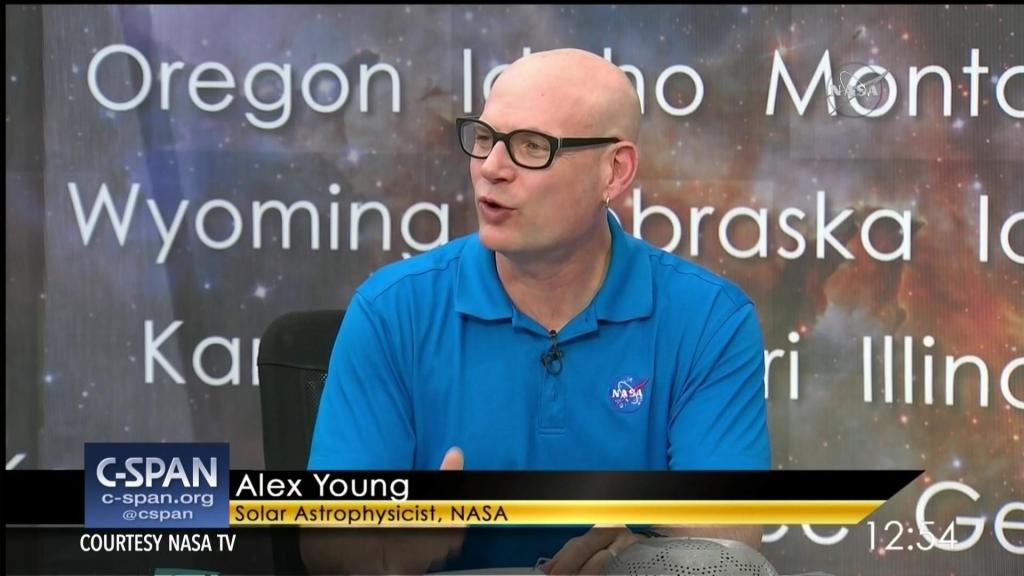
NASA EDGE: MMS Launch Live – March 13, 2015
NASA EDGE finishes its four year mission to follow the amazing Magnetospheric Multiscale Mission with live coverage atop the Operations Services Building II at NASA Kennedy Space Center. Guests include Alex Young, Susan Pope, Craig Pollock, Mic Woltman, Paul Gross and Troy Cline.
CREDIT: NASA Edge
NASA EDGE: Solar Max-Storm Warning – 2013
NASA EDGE: Transit of Venus – June 5 – 6, 2012
NASA EDGE covers the Transit of Venus from NASA’s Infrared Telescope Facility atop Mauna Kea in Hawaii. A special 6.5 hour live broadcast was planned, with teams at the Mauna Kea Observatory, Alaska, NASA Goddard Space Flight Center, NASA Ames and more. Alex Young will be on-air with other experts from NASA Learn more about this amazing event »
CREDITS: NASA Goddard Space Flight Center
Recorded & Live TV Interviews for NASA
Pre-recorded segments involve production teams who are gathering pieces together. Science communication involves storytelling with multiple video angles, sets, graphics, videos, and B-rolls so I’m not just a talking head. The audience needs to be engaged and connect with me, a real human, who loves science. I want to share my excitement and also explain things in a way that people understand. For live shots, I need to be prepared for anything while on the air! It’s exciting to experience the styles and questions from different reporters. Often I’ll do multiple interviews in one day, and no two are the same.
Many scientists will be collecting data during the solar eclipse. NASA scientist Alex Young joins CBSN with more on what researchers will be looking for during this historical solar event. CREDITS: CBS News
Scientists and citizens alike are preparing for August 21, 2017, when a total solar eclipse will cross North America for the first time in 99 years. The rare event will start in Oregon and take less than two hours to reach South Carolina. Adriana Diaz reports. CREDITS: CBS This Morning
CREDITS: SOHO, SDO, WJZ CBS Baltimore
August 17, 2017 Eclipse
Our Sun’s Magnetic Flip
Sunspots
Comet ISON
Mercury Transit
CREDITS: NASA Goddard Space Flight Center
NASA Hangouts (Live Group Online)
Van Allen Probes Discoveries – March 1, 2013
NASA’s Van Allen Probes revealed a new radiation belt around Earth
The Van Allen Probes mission discovered a previously unknown third radiation belt around Earth, revealing the existence of unexpected structures and processes within these hazardous regions of space.
Join a LIVE Q&A with NASA and Applied Physics Laboratory scientists and Washington Post Reporter Brian Vastag at 1 p.m. EST on Friday Mar. 1, 2013 to learn about these historic discovery. These two nearly identical spacecraft launched in August 2012 and with only six months in operation, they may well rewrite science textbooks.
The probes study the Van Allen belts, gigantic radiation belts surrounding Earth, which can swell dramatically in response to incoming energy from the sun, engulfing satellites and spacecraft and creating potential threats to manned space flight.
James Van Allen discovered the radiation belts during the 1958 launch of the first successful U.S. satellite. Subsequent missions have observed parts of the belts, but what causes the dynamic variation in the region has remained something of a mystery.
Participants: David Sibeck, NASA Van Allen Probes Mission Scientist; Shri Kanekal, NASA Van Allen Probes Deputy Mission Scientist; Alex Young, NASA Space Weather Scientist; Brian Vastag, Washington Post Science Reporter; Sasha Ukhorskiy, Johns Hopkins Applied Physics Lab
CREDIT: NASA Goddard Space Flight Center
Comet ISON LIVE – November 28, 2013
The ultimate battle of fire and ice! Who will win, the sun or Comet #ISON? Join #NASA as we followed the journey of Comet ISON as it slingshot around the sun.
During this LIVE event NASA scientists answered: Will the awesome gravity and energy of the sun break up this cosmic ball of ice and rock? Will it break up? Or will it pass the sun intact to put on a dazzling show in the December sky?
NASA solar physicists tracked the comet LIVE from the mission control for NASA’s Solar Dynamics Observatory,@NASA_SDO, during #ISON’s closest approach to the sun.
We were also joined by comet scientists from Kitt Peak Observatory in Arizona, where the solar telescope will be observing ISON and by science writer Phil Plait.
NASA scientists answered your questions LIVE on air on Google+, in the YouTube comments section during the live broadcast, or via Twitter using #ISON and #askNASA.
The participants in this Hangout included:
- C. Alex Young, Solar Physicist, Associate Director for Science in the Heliophysics Science Division and co-founder of The Sun Today – NASA’s Goddard Space Flight Center, Greenbelt, Md.,
- W. Dean Pesnell, Solar Physicist and Project Scientist for the Solar Dynamics Observatory – NASA’s Goddard Space Flight Center, Greenbelt, Md.,
- Karl Battams, Comet Scientist for the Naval Research Laboratory, Washington, DC, and solar spacecraft lead for NASA’s Comet ISON Observing Campaign, joining from Kitt Peak Observatory in Arizona, where the solar telescope will be observing ISON.
- Phil Plait, writes Slate’s ‘Bad Astronomy’ blog and is an astronomer, science evangelizer, and author of the books “Bad Astronomy” and “Death from the Skies!”
CREDIT: NASA Goddard Space Flight Center
Uncovering the Secrets of Asteroids on NASATV – September 7, 2016
During this panel, NASA scientists (including myself) will discuss asteroids, how they relate to the origins of our solar system, and the search for life beyond Earth. Panelists for this conversation are:
- Ellen Stofan, NASA chief scientist
- Michelle Thaller, Deputy Director of Science Communications for NASA’s Science Mission Directorate
- Lindley Johnson, Director of the Planetary Defense Coordination Office in NASA’s Science Mission Directorate
- Alex Young, Associate Director for Science in the Heliophysics Science Division at Goddard
credit: NASA/SVS/OSIRIS-REx
NASA Videos
Our World: Sun’s Position
August 17, 2020 – Find out more about how our sun’s position in the sky changes due to Earth’s rotation, revolution, and tilt. Learn from the experts — Dr. Alex Young and Dr. Nicki Viall explain these connections so students understand patterns within the Earth-Sun.
Facebook Live about Eclipse 2017
2012: Killer Solar Flares Are a Physical Impossibility
Should we be concerned about solar storms in 2012? Heliophysicist Alex Young from NASA Goddard Space Flight Center sorts out truth from fiction.
Given a legitimate need to protect Earth from the most intense forms of space weather – great bursts of electromagnetic energy and particles that can sometimes stream from the sun – some people worry that a gigantic “killer solar flare” could hurl enough energy to destroy Earth. Citing the accurate fact that solar activity is currently ramping up in its standard 11-year cycle, there are those who believe that 2012 could be coincident with such a flare.
But this same solar cycle has occurred over millennia. Anyone over the age of 11 has already lived through such a solar maximum with no harm. In addition, the next solar maximum is predicted to occur in late 2013 or early 2014, not 2012.
The Solar and Heliospheric Observatory (SOHO) spacecraft captured this image of a solar flare as it erupted from the sun early on Tuesday, October 28, 2003. This was the most powerful flare measured with modern methods.
Most importantly, however, even the biggest solar flares are not powerful enough to physically destroy Earth.
This is not to say that space weather can’t affect our planet. The explosive heat of a solar flare can’t make it all the way to our globe, but electromagnetic radiation and energetic particles certainly can. Solar flares can temporarily alter the upper atmosphere creating disruptions with signal transmission from, say, a GPS satellite to Earth causing it to be off by many yards. Another phenomenon produced by the sun could be even more disruptive. Known as a coronal mass ejection (CME), these solar explosions propel bursts of particles and electromagnetic fluctuations into Earth’s atmosphere. Those fluctuations could induce electric fluctuations at ground level that could blow out transformers in power grids. The CME’s particles can also collide with crucial electronics onboard a satellite and disrupt its systems.
In an increasingly technological world, where almost everyone relies on cell phones and GPS controls not just your in-car map system, but also airplane navigation and the extremely accurate clocks that govern financial transactions, space weather is a serious matter.
But it is a problem the same way hurricanes are a problem. One can protect oneself with advance information and proper precautions. During a hurricane watch, a homeowner can stay put . . . or he can seal up the house, turn off the electronics and get out of the way. Similarly, scientists at NASA and NOAA give warnings to electric companies, spacecraft operators, and airline pilots before a CME comes to Earth so that these groups can take proper precautions. Improving these predictive abilities the same way weather prediction has improved over the last few decades is one of the reasons NASA studies the sun and space weather. We can’t ignore space weather, but we can take appropriate measures to protect ourselves.
And, even at their worst, the sun’s flares are not physically capable of destroying Earth.
CREDIT: Karen C. Fox & NASA Goddard Space Flight Center
Solar Eclipse August 2008
[Narrator] On the first of August 2008 a rare and awe-inspiring event will take place, a total solar eclipse. Skies over Canada, Greenland, Russia, Mongolia, and China will darken, as the sun is completely blocked out by the moon. Over the centuries, these striking events have inspired countless inquiries and questions, so we posed some to our resident eclipse experts.
[Fred Espenak] A solar eclipse takes place whenever the moon passes between the Earth and the sun and some portion of it’s shadow passes across the Earth’s surface.
[Alex Young] One of the important things is as many people have probably heard growing up, you should never look at the sun directly because it would damage your eyes. And the same thing is true during an eclipse; the only time when it is actually safe to look at the sun is exactly at totality. So otherwise you need to either have special glasses with a filter or you can have a filter on a telescope or if you have a telescope that projects the image on to a screen or even you can make a pinhole camera that projects the image on to a screen.
[Fred Espenak] During a total eclipse it give scientists a rare opportunity to make direct measurements of the sun’s corona with all types of instruments and measure it at different wavelengths, measure it at different frequencies, once a second, twenty times a second, a hundred times a second, with different size telescopes, which are always improving.
[Alex Young] Soon we’ll be launching, at the end of this year, something called the Solar Dynamics Observatory, which is going to give us an unprecedented view of the sun, in a whole bunch of different wavelengths all at the same time and very fast. So we’re very excited about that.
[Narrator] The August first solar eclipse promises to be a stunning event.
And while only people in a small area of the world will be able to see the eclipse in person, viewers all across the globe can watch the event on NASA TV and online at www.NASA.gov.
CREDIT: NASA Goddard Space Flight Center
National Solar Observatory
Solar from the Scientists: Dr. C. Alex Young
Dr. Alex Young tells us how the Sun’s magnetic activity results in solar storms, and how it affects life on Earth.
CREDITS: National Science Foundation
Twit.TV
How Space Weather Could Affect Electronics
NASA Astrophysicist C. Alex Young talks with Leo Laporte and Iain Thomson about solar flares and other space weather that could negatively affect electronics here on Earth. They discuss how NASA is monitoring this weather and what we should do in the worst case scenario. Watch the full episode here.
TWiT.tv is a technology podcasting network located in the San Francisco Bay Area with the #1 ranked technology podcast This Week in Tech hosted by Leo Laporte. Every week we produce over 30 hours of content on a variety of programs including Tech News Today, The New Screen Savers, MacBreak Weekly, This Week in Google, Windows Weekly, Security Now, All About Android, and more.
CREDIT: TWiT.tv
NASA Promos
CREDITS: NASA Goddard Space Flight Center
CREDITS: The Science & Entertainment Exchange is a program of the National Academy of Sciences that provides entertainment industry professionals with access to top scientists and engineers to help bring the reality of cutting-edge science to creative and engaging storylines. Learn more at www.scienceandentertainmentexchange.org.


